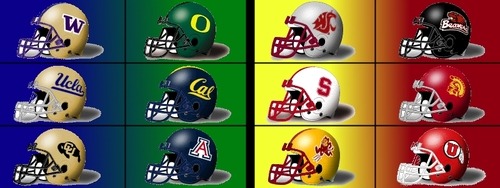Alternately you follow the SEC blueprint -- Geographic division (East/West), one dedicated cross-over game, and equal revenue sharing. They have probably proven (even moreso than the Big 10) that they know how to succeed both financially and on the field.
First, it should be 2 cross-over games. With a 9-game conference slate (SEC plays 8), it makes a ton of scheduling sense to have the 5 divisional games, 2 fixed cross-over games, and a 2/4 year rotation for the other cross-over matchups.
Consider this, though. Let's say we do the "zipper" with the 2 fixed cross-over games. Based on the East/West relationship of the paired universities, you'd end up with the following:
West: UCLA, Stanford, Oregon State, Washington, Arizona State, Utah
East: USC, Cal, Oregon, Washington State, Arizona, Colorado
Then, to use UCLA as an example, you'd play USC and Cal every year, your 5 divisional games, and the other 4 teams every 2 of 4 years.
What's nice about this is that it protects the regional rivalries, is very closely balanced for media markets, is very closely balanced for competitiveness, and ensures that every program makes a trip to every geographic area of the conference at least 3 out of every 4 years.
To me, all of those factors are easily trumping whether someone in New York (who probably couldn't name all 12 teams anyway) is able to intuitively understand the divisional alignment.
Edit: This is very close to the "Pac-12 Cooler" idea. The basic graphic looks like this, with the teams on the same horizontal line always playing rivalry matchups and the teams on either side of the dark vertical line representing the 2 divisions. I'd just change the divisions based on the east/west zipper:
LINK

